|
NOHAB
NOHAB (Nydqvist & Holm AB) was a manufacturing company based in the city of Trollhättan, Sweden. History The company was founded by Antenor Nydqvist, Johan Magnus Lidström and Carl Olof Holm in 1847 as ''Trollhättans Mekaniska Verkstad'' as a manufacturer of turbines for hydraulic power plants. In 1865, the company made its first steam locomotive and in 1912 the 1,000th locomotive steamed out of the factory. In Nohab's anniversary book "The Thousand Locomotive" from 1912, it's mentioned that the company also manufactured davits for Titanic's lifeboats. In 1916 the company was reconstituted as a limited company and became NOHAB. In 1920, NOHAB received an order of 1000 locomotives from Soviet Russia. Only 500 were delivered between 1921 and 1924. In 1924, Nohab built three steam locomotives, 4-6-0 ones for with the respective builder's plates #1727, #1728 and #1729 for Estrada de Ferro Rio d'Ouro in the state of Rio de Janeiro (Brazil). According to E.F. Rio d'Ouro's su ... [...More Info...] [...Related Items...] OR: [Wikipedia] [Google] [Baidu] |
NSB Di 3
NSB Di 3 is a class of 35 diesel–electric locomotives built by NOHAB for the Norwegian State Railways (NSB). The class was built between 1954 and 1969, and delivered in two series, Di 3a and Di 3b. They are based on the EMD F7, Electro-Motive Division F7 and are equipped with EMD 567 engines. They have a distinct bulldog nose and were numbered 602–633 (a-series) and 641–643 (b-series). The locomotives had a prime mover that gives a power output of . The a-series has a Co′Co′ wheel arrangement, while the b-series has A1A-A1A, (A1A)(A1A). The b-series has higher top speed, but lower tractive effort. The class was the dominant locomotive on NSB's unelectrified lines. It was ordered as part of the company's dieselization of services during the 1950s and 1960s, and was initially used on the three mainline routes of the Bergen Line, Bergen, Dovre Line, Dovre and Nordland Lines. In the 1960s the Bergen and Dovre Lines were railway electrification system, electrified and the Di ... [...More Info...] [...Related Items...] OR: [Wikipedia] [Google] [Baidu] |
M62 Locomotive
The M62 is a Soviet-built diesel locomotive for heavy freight trains, exported to many Eastern Bloc countries as well as to Cuba, North Korea and Mongolia. Besides the single locomotive M62 also twin versions 2M62 and three-section versions 3M62 have been built. A total number of 7,164 single sections have been produced, which have been used to build 5,231 single-, twin- and three-section locomotives. History According to the Comecon directives production of heavy diesel locomotives among Eastern Bloc countries was left exclusively to Romania and the Soviet Union. The M62 was developed by the Vorohsilovgrad Locomotive Factory (today: Luhansk Locomotive Factory) on order of Hungary. The M62 designation originates from the Hungarian order, as the Hungarian railways previously ordered Swedish locomotives called M61 in Hungary. The Soviets disliked this and forced Hungary to buy Soviet locomotives, but the USSR did not have suitable diesel locomotives at the time, spurring the developm ... [...More Info...] [...Related Items...] OR: [Wikipedia] [Google] [Baidu] |
Electro-Motive Diesel
Electro-Motive Diesel (abbreviated EMD) is a brand of diesel-electric locomotives, locomotive products and diesel engines for the rail industry. Formerly a division of General Motors, EMD has been owned by Progress Rail since 2010. Electro-Motive Diesel traces its roots to the Electro-Motive Engineering Corporation, founded in 1922 and purchased by General Motors in 1930. After purchase by GM, the company was known as GM's Electro-Motive Division. In 2005, GM sold EMD to Greenbriar Equity Group and Berkshire Partners, and in 2010, EMD was sold to Progress Rail, a subsidiary of the heavy equipment manufacturer Caterpillar Inc., Caterpillar. Upon the 2005 sale, the company was renamed to Electro-Motive Diesel. EMD's headquarters and engineering facilities are based in McCook, Illinois, while its final locomotive assembly line is located in Muncie, Indiana. EMD also operates a traction motor maintenance, rebuild, and overhaul facility in San Luis Potosí City, San Luis Potosí, Mexico ... [...More Info...] [...Related Items...] OR: [Wikipedia] [Google] [Baidu] |
4-6-0
A 4-6-0 steam locomotive, under the Whyte notation for the classification of steam locomotives by wheel arrangement, has four leading wheels on two axles in a leading bogie and six powered and coupled driving wheels on three axles with the absence of trailing wheels. In the mid-19th century, this wheel arrangement became the second-most-popular configuration for new steam locomotives in the United States, where this type is commonly referred to as a ten-wheeler.White, John H., Jr. (1968). ''A history of the American locomotive; its development: 1830-1880''. New York, NY: Dover Publications. p. 57. As locomotives pulling trains of lightweight all-wood passenger cars from the 1890 to the 1920s, they were exceptionally stable at near speeds on the New York Central's New York-to-Chicago Water Level Route and on the Reading Railroad's line from Camden to Atlantic City, New Jersey. Overview Tender locomotives During the second half of the nineteenth and first half of the twen ... [...More Info...] [...Related Items...] OR: [Wikipedia] [Google] [Baidu] |
Portuguese Train Type 0100
The Série 0100 are a type of single carriage diesel railcar built for Portuguese Railways (CP). They were built by NOHAB of Trollhättan in Sweden in 1948. They were extensively refurbished in 1980. As of 2012 only six units are still in Portugal; the other six were sold to Argentina Argentina, officially the Argentine Republic, is a country in the southern half of South America. It covers an area of , making it the List of South American countries by area, second-largest country in South America after Brazil, the fourt ... and the rest were destroyed by fire or accidents. As of 2013 none are in service in Portugal. Three similar, but smaller, Série 9100 railcars were also supplied by NOHAB in 1949 for use on the metre gauge Tâmega line in northern Portugal. References {{Rolling stock of Portugal Diesel multiple units of Portugal ... [...More Info...] [...Related Items...] OR: [Wikipedia] [Google] [Baidu] |
Saab Group
Saab AB (originally , , acronym SAAB), with subsidiaries collectively known as the Saab Group (), is a Swedish aerospace and defence company primarily operating from Sweden. The company is headquartered in Stockholm, but its development and manufacturing operations are undertaken in Linköping. The company was formally founded by AB Bofors in 1937, by reforming the aero engine division of company NOHAB (founded in 1930), located in Trollhättan, into a proper aircraft manufacturer. It would soon merge with aircraft manufacturer ASJA (founded in 1931), located in Linköping, in 1940, which had it own design bureau and is considered the spiritual predecessor to today's Saab AB. This formed the SAAB- concern, with the factory in Trollhättan becoming ''SAAB/T'' and the factory in Linköping (previously ASJA) becoming ''SAAB/L'' and design headquarters. From 1947, Saab started producing automobiles, the automobile division being spun off as Saab Automobile in 1990, a joint vent ... [...More Info...] [...Related Items...] OR: [Wikipedia] [Google] [Baidu] |
Portuguese Train Type 9100
The Série 9100 were a class of metre gauge diesel railcars built for use by the Portuguese Railways (CP) on the Tâmega line. Three 9100 series railcars were built in 1949 by Swedish manufacturer NOHAB of Trollhättan. They were essentially a narrow gauge version of CP's larger Iberian broad gauge Série 0100 diesel railcars. They were in revenue service until 2002, when they were withdrawn and replaced by the new CP Série 9500 railcars. Gallery File:CP 9102-JPVL.JPG, two CP 9100 railcars in Livração in 2003 File:07.11.93 Amarante 9101 (33216405085).jpg, CP 1901 at Amarante on 7 November 1993 File:Automotora (24319600278).jpg References See also Related articles *Narrow gauge railways in Portugal Portugal formerly had several hundred kilometres of narrow-gauge railways, but by 2010 only two lines were still in operation – the Vouga line and the Metro de Mirandela. The lines were operated by Comboios de Portugal and maintained by REF ... External link ... [...More Info...] [...Related Items...] OR: [Wikipedia] [Google] [Baidu] |
Wärtsilä
Wärtsilä Oyj Abp (), trading internationally as Wärtsilä Corporation, is a Finnish corporation, Finnish company which manufactures and services power sources and other equipment in the Marine propulsion, marine and energy markets. The core products of Wärtsilä include technologies for the energy sector, including gas, multi-fuel, liquid fuel and biofuel power plants and energy storage systems; and technologies for the marine sector, including cruise ships, ferries, fishing vessels, merchant ships, navy ships, special vessels, tugs, yachts and offshore vessels. Ship design capabilities include ferries, tugs, and vessels for the fishing, merchant, offshore and special segments. Services offerings include online services, underwater services, turbocharger services, and also services for the marine, energy, and oil and gas markets. At the end of December 2023, the company employed 17,800 workers. Wärtsilä has two main businesses; Energy Business focusing on the energy marke ... [...More Info...] [...Related Items...] OR: [Wikipedia] [Google] [Baidu] |
DSB (railway Company)
DSB, an abbreviation of ''Danske Statsbaner'' (, ''Danish State Railways''), is the largest Danish train operating company. It's also the largest train operating company in Scandinavia. While DSB is responsible for passenger train operation on most of the Danish railways, goods transport and railway maintenance are outside its scope. DSB runs a commuter rail system, called the S-train, in the area around the Danish capital, Copenhagen, that connects the different areas and suburbs in the greater metropolitan area. Between 2010 and 2017, DSB operated trains in Sweden. DSB was founded in 1885, when the state-owned companies ''De jysk-fynske Statsbaner'' and ''De sjællandske Statsbaner'' merged. DSB was established in 1885, after the state in 1867 under the name De Jutland-Fynske Statsbaner took over the private company Det Danske Jernbanedriftselskab and in 1880 they also took over the privately owned Zealand Railway Company. History The first railways in Denmark were built a ... [...More Info...] [...Related Items...] OR: [Wikipedia] [Google] [Baidu] |
Trollhättan
Trollhättan () is the 23rd-largest city in Sweden, the seat of Trollhättan Municipality, Västra Götaland County. It is situated by Göta älv, near the lake Vänern, and has a population of approximately 50,000 in the city proper. It is located 75 km (46 mi) north of Sweden's second-largest city, Gothenburg. History Trollhättan was granted city rights (which today have no legal effect) in 1916 at which time it had about 15,000 inhabitants, now grown to 59,058. Trollhättan was founded on the river Göta älv, at the Trollhättan Falls. The site was first mentioned in literature from 1413. Trollhättan had a strategic significance on the road between Västergötland and Norway. It was also of a commercial and political significance for shipping to and from Vänern. Utilization of the river falls was the first important business activity in the area. From the Middle Ages milling and sawing operations have been conducted where the city center is now located. Fo ... [...More Info...] [...Related Items...] OR: [Wikipedia] [Google] [Baidu] |
Steam Locomotive
A steam locomotive is a locomotive that provides the force to move itself and other vehicles by means of the expansion of steam. It is fuelled by burning combustible material (usually coal, Fuel oil, oil or, rarely, Wood fuel, wood) to heat water in the locomotive's Boiler (power generation), boiler to the point where it becomes gaseous and its volume increases 1,700 times. Functionally, it is a steam engine on wheels. In most locomotives, the steam is admitted alternately to each end of its Steam locomotive components, cylinders in which pistons are mechanically connected to the locomotive's main wheels. Fuel and water supplies are usually carried with the locomotive, either on the locomotive itself or in a Tender (rail), tender coupled to it. #Variations, Variations in this general design include electrically powered boilers, turbines in place of pistons, and using steam generated externally. Steam locomotives were first developed in the United Kingdom of Great Britain an ... [...More Info...] [...Related Items...] OR: [Wikipedia] [Google] [Baidu] |





